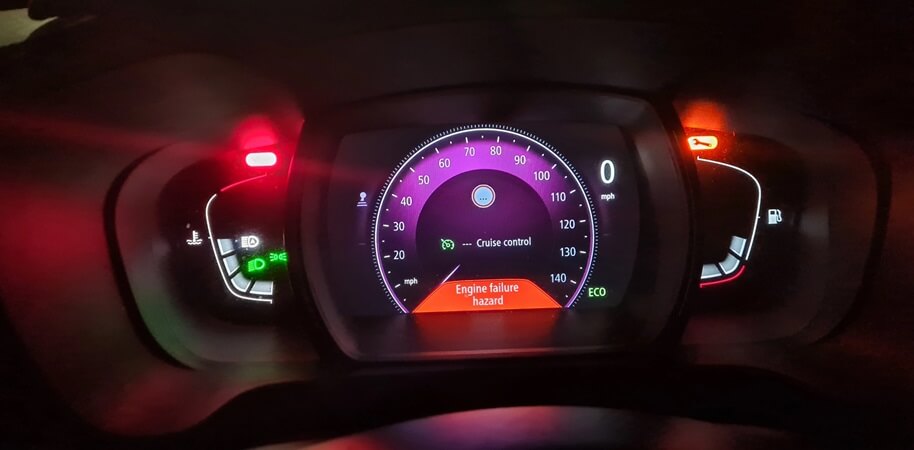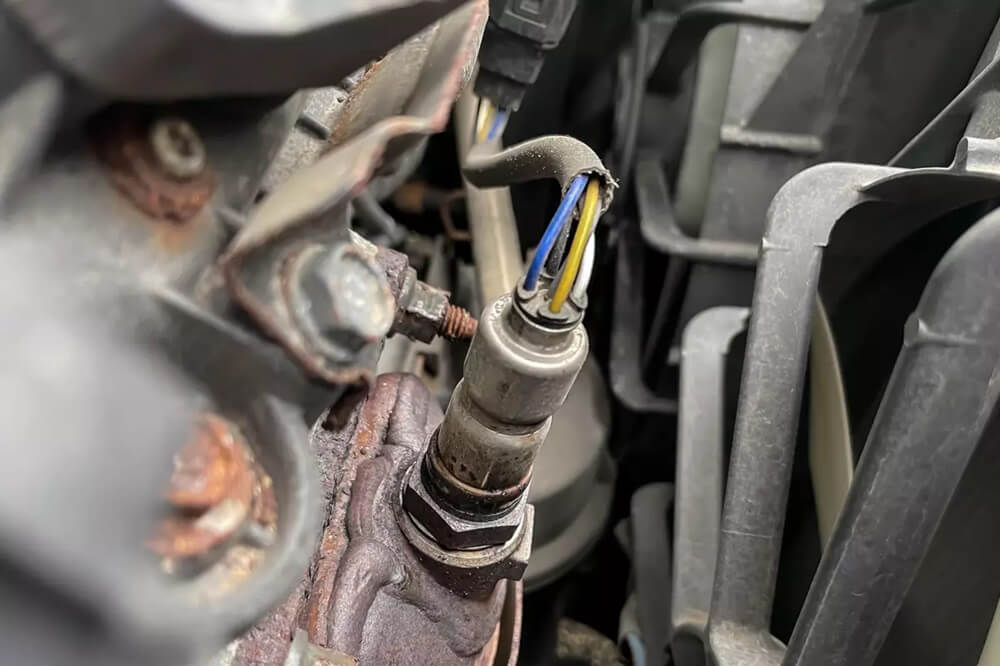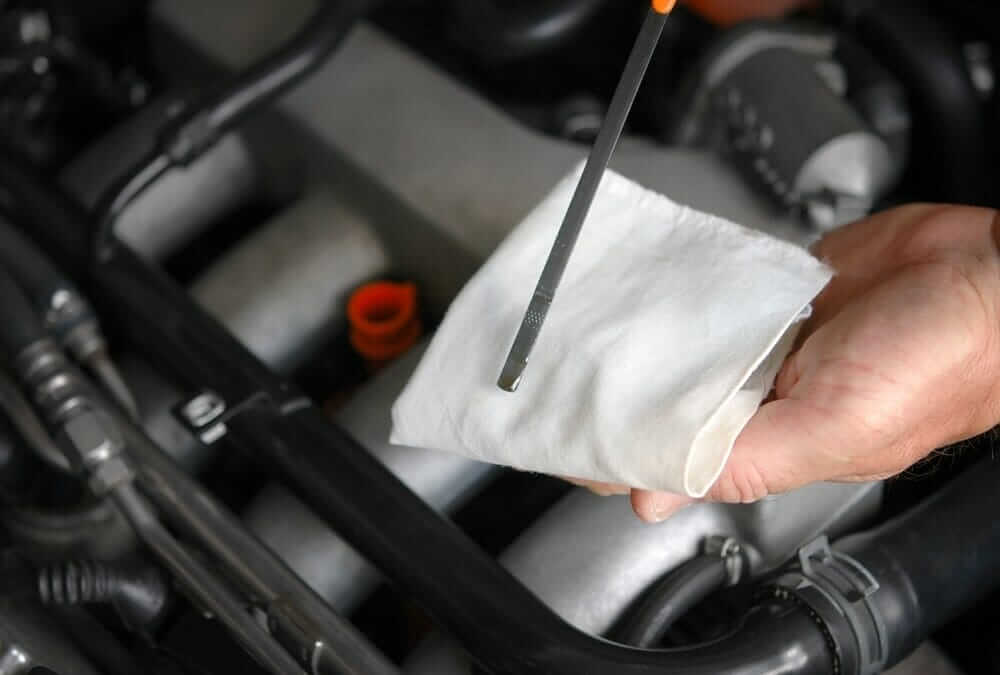As a Renault owner, seeing the warning “Engine Failure Hazard” on your car’s dashboard can make you feel worried and uneasy. Even though this is a reason to be concerned, there might be several other reasons why it appears on your Renault dashboard.
Meaning Of “Engine Failure Hazard” Warning on a Renault
On a Renault including popular models like the Renault Clio, Trafic, Fluence, Grand Scenic, and Laguna 3, the engine control unit (ECU) has recognized a potential malfunction or engine overheating, leading to the display of the “Engine Failure Hazard” alert. The purpose of this warning, which comes from the vehicle’s onboard diagnostics system, is to notify the driver of a problem that requires attention.

This dashboard warning light suggests that issues may prevent the engine from running as intended. The severity of the reasons can vary, from minor issues like malfunctioning oxygen (O2) sensors to more significant severe concerns like a damaged thermostat.
What Causes an Engine Failure Hazard Fault on a Renault?
Based on my in-depth research and years of experience as an auto mechanic, this message will show up on your Renault dashboard if any of the following happens:
1. Faulty Catalytic Oxygen Sensor
If your Renault is having problems with engine failure, this could be one of the reasons. Not only that, however, but it is additionally one of the best to fix.
Putting in an oxygen sensor will let you recognize how much oxygen is moving around in your engine’s exhaust. The powertrain control module (PCM) tests the fuel/air combination to see if it’s too much or too little after getting a sign from the oxygen sensors.

This helps keep your Renault running efficiently and correctly by ensuring all fuel is used. There is a top risk that these sensors may malfunction.
If your two sensors are not working right, the “Engine failure hazard” warning light will come on. If your engine does not get enough airflow, it will misfire or run poorly, mainly when it is warm outside.
2. Leaks Prevent The Radiator From Getting The Proper Coolant:
When this happens to Renaults, another common reason is a leak radiator. If your Renault’s radiator does not get enough coolant, the engine will get too warm because the radiator’s job is to cool the engine.
Here are some signs and symptoms that this may be the case:
- When it is warm outside.
- The exhaust pipe emits white smoke when you start the car.
- Coolant is leaking from your car’s vents or underneath the vehicle.
If your Renault receives hotter than usual, the engine failure hazard message will appear on the computer, letting you know what’s wrong.
3. Broken Thermostat
The thermostat is a necessary part of the cooling system as it keeps the engine of your Renault at the correct temperature.
To do this, it operates a valve in the coolant system, allowing air to flow into and out of the radiator. This helps maintain the engine’s temperature constant.
If the thermostat in your Renault is stuck in the open position, you may not be capable of changing the engine temperature. The “Engine failure hazard” may happen if the engine becomes too hot.
If you see this error message, you must closely monitor the coolant temperature. The radiator should be leaking, there would no longer be sufficient coolant, or the thermostat should be damaged if it is too high.
4. Not Enough Motor Oil
Renault depends on oil to cool, lubricate, and maintain its moving parts running smoothly. If there is insufficient oil, the car could seize up.

If you have not performed these tasks recently, you have to look at the oil level and change the oil if necessary. Examine the amount of oil in the engine and add extra if needed if you see the engine failure hazard fault message. This should be because the oil level is too low.
5. Faulty Spark Plugs
The engine failure hazard may come on if the spark plugs are faulty. This may cause the engine to make much less power, and if you put extra pressure on it, it could run roughly or even stop.
Similar Posts:
How To Fix Engine Failure Hazard Renault
Fixing and resetting the “Engine Failure Hazard” light on a Renault includes typically figuring out and addressing the problem that triggered the warning. Here are some steps to diagnose and reset the warning light:
1. Diagnostic Scan:
- Use an OBD 2 (Onboard Diagnostics) scanner to perform a diagnostic scan on the vehicle.
- Connect the scanner to the OBD port, usually found under the dashboard.
- Collect the error codes saved in the ECU that caused the “Engine Failure Hazard” warning.
2. Consult with a Professional:
- Take your Renault to the nearest Renault dealer or a certified Renault specialist.
- Professionals will use superior diagnostic equipment to analyze the error codes and understand the exact problem.
- They can provide correct data about the problem, the repair fee, and which factors may also want to be replaced.
3. Address the Specific Issue:
- Once the issue is identified, follow the recommended repairs or replacements suggested by the professionals.
- Common issues, such as misguided O2 sensors, a broken thermostat, or problems in the cooling system.
4. Resetting the Warning Light:
- After the essential repairs or replacements are made, the OBD scanner can clear the error codes and reset the “Engine Failure Hazard” warning light.
- Some motors may automatically clear the warning light after the issue is resolved, while others may require manual intervention in using the scanner.
5. Follow Manufacturer’s Guidelines:
- Consult the car’s manual or seek guidance from the manufacturer on specific techniques for resetting the warning light.
- Some cars may require a specific sequence of actions to reset the light. It’s important to note that while the above steps provide a general guideline, the specifics may vary depending on the Renault model and year. Always check the vehicle’s manual for model-specific instructions.


![[FIXED] Engine Failure Hazard Renault: Meaning & Causes Engine Failure Hazard Renault](https://carstale.com/wp-content/uploads/engine-failure-hazard-renault-1024x576.jpg)